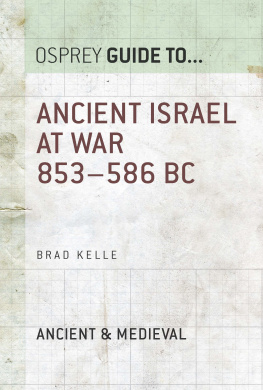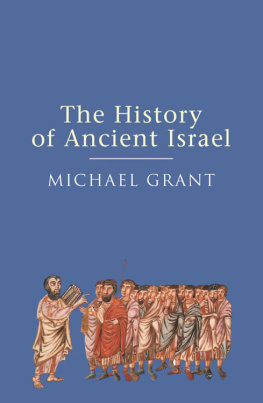Guide To
Ancient Israel at War
853-586 BC
Brad Kelle

Contents
Introduction
Among the powers
In the mid-9th century BC , the ancient kingdoms of Israel and Judah existing in the territories now referred to as the Holy Land, Israel, or Palestine were two of several small kingdoms subsumed under an Assyrian Empire, ruled from the banks of the Euphrates River. By the latter part of the 8th century, Assyria had destroyed the Kingdom of Israel. Little more than a century later, the Kingdom of Judah suffered a similar fate at the hands of the Babylonians. Although Judah would later regain an identity, the events of this ancient time shaped a wealth of literature and continue to influence modern thinking about the so-called Middle East.
This book examines the major military conflicts of the kingdoms of Israel and Judah from their earliest recorded encounter with the Assyrians in 853 BC , to the final destruction of Jerusalem by the Babylonians in 586 BC . These wars can provide insights into the political developments that shaped the broader history of the Ancient Near East, and the social realities that shaped the lives of ordinary people in these ancient kingdoms.
Within the broader political history of the Ancient Near East, this period first saw the dominance of the Neo-Assyrian Empire. This empire emerged in earnest around 900, and extended its dominance westward to the Mediterranean Sea by the mid-870s.
For the next two centuries, as Assyrias fortunes waxed and waned, the Empire maintained various vassal states and annexed provinces throughout the Ancient Near East. By 605, however, a weakened Assyria gave way to the Neo-Babylonian Empire. With the help of other groups like the Medes, the Babylonians assumed control of virtually all territories from the Euphrates River to the Mediterranean Sea south of Anatolia (modern Turkey) and north of Egypt. This dominance would last for nearly a century until the Babylonian Empire itself gave way to the Medes and Persians in 539.
Among these empires, many smaller kingdoms played significant roles in regional and imperial politics. Egypt exerted influence at various times throughout the region. Smaller kingdoms like Phoenicia, Philistia, Ammon, Moab, Edom, Israel, and Judah also vied for power with one other and in relation to the empires. The Kingdom of Aram-Damascus, which was located to the northeast of Israel, particularly achieved dominance around the Jordan River even dominance over Israel and Judah from 841 to 805 but was ultimately destroyed by Assyria around 732.
Six major periods of military conflict for Israel and Judah occurred in the context of these empires and kingdoms:
1) In 853, Israel participated in a coalition led by Aram-Damascus, which opposed the Assyrians at the battle of Qarqar;
2) 843805 was a period of sustained conflict among Israel, Judah, and Aram-Damascus as a result of the rise of Aram-Damascus during a period of Assyrian weakness;
3) From 734 to 731, war broke out between Israel and Judah when Israel entered into an alliance with Aram-Damascus and attempted to capture Jerusalem from Judah;
4) 730720 witnessed Israels sustained engagement in various rebellions against Assyria;
5) After the destruction of the Kingdom of Israel, the years 714701 included two major conflicts in which Judah attempted to throw off Assyrian domination;
6) 597586 witnessed two conflicts in which Judah rebelled against the newly formed Babylonian Empire and ultimately fell victim to provincialization.
The Bible and Israels history
For the history of ancient Israel and Judah, the historian is in the unique position of having a widely read document that claims to present the story of these two kingdoms in a comprehensive way. That document is what Jews call the Bible and Christians call the Hebrew Bible or Old Testament portion of their scripture, which also contains the New Testament. The existence of the Bible, however, presents the historian with a dilemma. On the one hand, other non-biblical or extra-biblical sources exist that are not as comprehensive, but are more contemporary with the events under consideration. On the other hand, the Hebrew Bible/Old Testament (HB/OT) is more comprehensive, but the question of its historical accuracy is complicated.
With regard to the extra-biblical sources, the Israelites participation in the battle of Qarqar in 853 is the first mention of Israel in the records of the Assyrian Empire. There are no clear Assyrian, Babylonian, or Egyptian texts that give detailed evidence for Israel and Judah during the earlier periods of their presumed existence (e.g. 13th10th centuries BC ). After 853, however, there are large numbers of textual and archeological sources, yet they offer only a small amount of straightforward, particularly first-hand material concerning Israel and Judah. Archeologists have discovered, for example, some texts from ancient Israel itself that date from the 9th to the 6th centuries BC . These are not in the form of royal annals or king-lists, but rather tend to be local and occasional documents, like ostraca (inscribed potsherds) and seals, or Hebrew inscriptions and letters, like records of economic transactions. Textual sources from neighboring cultures are more numerous, especially the surviving collections of royal inscriptions from Assyria, Babylonia, and Egypt. Assyrian royal annals and Eponym Chronicles (or limmu-lists), compositions that give chronological accounts of the achievements of various Assyrian kings, provide some specific references to rulers and events in Israel and Judah, as does a variety of local correspondence.
With regard to the biblical material, the HB/OT contains two overlapping accounts of Israelite and Judean history in the Assyrian and Babylonian periods: 1 Kings 16 to 2 Kings 23, and 2 Chronicles 1735. The former is generally considered to be part of a larger work called the Deuteronomistic History, which includes the biblical books of Joshua through to 2 Kings. A first version of this composition may have its origins in the 8th or 7th century BC , but the biblical version clearly results from various additions and editing in later centuries. The Chronicles account apparently stems from the 4th century BC , with even later revisions. Both compilations indicate that they draw upon earlier sources such as the Book of the Annals of the Kings of Israel/Judah, sources that have not yet been discovered.
As a result of the prominence of these biblical texts, most of the research on Israelite and Judean history has taken place within the field of study known as modern biblical criticism. Such study can be significantly different in both its assumptions and practices from the kinds of scripture reading done in modern synagogues and churches. In this field, the HB/OT is not viewed as a unified, coherent, and inerrant divine authority, but is recognized as being a compilation of historically conditioned writings, which were constructed over long periods of time, contain multiple genres and literary conventions, and reflect the ideologies and contexts of their writers. Especially since the 1970s, historians have increasingly taken note of the literary and ideological nature of the biblical texts, namely that the Bible, like all ancient sources, contains artistic conventions, class and gender biases, and ideological programs. Additionally, the majority of the biblical narratives appear to have been written in the centuries after 586, a period long removed from the events they describe. Research in the last two decades has also frequently shown that many of the past archeological proofs used to support the Bibles basic story are inadequate.
Next page








